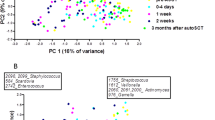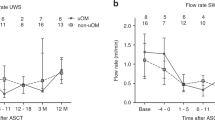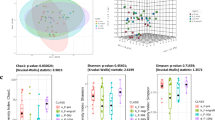Summary:
Autologous stem cell transplantation has augmented treatment successes. However, high-dose chemotherapy is still accompanied by dose-limiting toxicities, for example, severe mucositis. Mucosal lesions serve as portals of entry for infections. In order to reduce the oral microbial burden, we prospectively evaluated the microbiological impact of a complex regimen of mouth rinses consisting of concomitantly applied polyene antifungals, povidone-iodine, chlorhexidine, sage tea, and prophylactic ciprofloxacin and fluconazole. A total of 15 patients were enrolled into this longitudinal evaluation. Colony-forming units (CFU) were quantitated from saliva, buccal and palatinal swabs during high-dose chemotherapy and autologous stem cell transplantation. The number of CFU did not show any significant changes after initiation of the mouth rinses and the prophylactic antibiotics. The median CFU count was 268 × 106/ml saliva before chemotherapy and decreased after initiation of intravenous antibiotics only. Neither prophylactic nor therapeutic antifungals significantly reduced the number of cultures positive for yeasts. Since 90% of our patients had febrile neutropenia at some time point during the observation period, the approach evaluated cannot be recommended as prophylaxis of febrile neutropenia as such.
This is a preview of subscription content, access via your institution
Access options
Subscribe to this journal
Receive 12 print issues and online access
$259.00 per year
only $21.58 per issue
Buy this article
- Purchase on Springer Link
- Instant access to full article PDF
Prices may be subject to local taxes which are calculated during checkout

Similar content being viewed by others
References
Farquhar C, Basser R, Hetrick S et al. High dose chemotherapy and autologous bone marrow or stem cell transplantation versus conventional chemotherapy for women with metastatic breast cancer. Cochrane Database Syst Rev 2003; 1: CD003142.
Imrie K, Esmail R, Meyer RM . The role of high-dose chemotherapy and stem-cell transplantation in patients with multiple myeloma: a practice guideline of the Cancer Care Ontario Practice Guidelines Initiative. Ann Intern Med 2002; 136: 619–629.
Ferme C, Mounier N, Divine M et al. Intensive salvage therapy with high-dose chemotherapy for patients with advanced Hodgkin's disease in relapse or failure after initial chemotherapy: results of the Groupe d'Etudes des Lymphomes de l'Adulte H89 Trial. J Clin Oncol 2002; 20: 467–475.
Brice P, Simon D, Bouabdallah R et al. High-dose therapy with autologous stem-cell transplantation (ASCT) after first progression prolonged survival of follicular lymphoma patients included in the prospective GELF 86 protocol. Ann Oncol 2000; 11: 1585–1590.
Sweetenham JW, Santini G, Qian W et al. High-dose therapy and autologous stem-cell transplantation versus conventional-dose consolidation/maintenance therapy as postremission therapy for adult patients with lymphoblastic lymphoma: results of a randomized trial of the European Group for Blood and Marrow Transplantation and the United Kingdom Lymphoma Group. J Clin Oncol 2001; 19: 2927–2936.
Copelan EA, Penza SL, Pohlman B et al. Autotransplantation following busulfan, etoposide and cyclophosphamide in patients with non-Hodgkin's lymphoma. Bone Marrow Transplant 2000; 25: 1243–1248.
Meloni G, Capria S, Trasarti S et al. High-dose idarubicine, busulphan and melphalan as conditioning for autologous blood stem cell transplantation in multiple myeloma. A feasibility study. Bone Marrow Transplant 2000; 26: 1045–1049.
NCI Common Toxicity Criteria 2.0: NHI, DHHS; 1998.
Moreau P, Facon T, Attal M et al. Comparison of 200 mg/m(2) melphalan and 8 Gy total body irradiation plus 140 mg/m(2) melphalan as conditioning regimens for peripheral blood stem cell transplantation in patients with newly diagnosed multiple myeloma: final analysis of the Intergroupe Francophone du Myelome 9502 randomized trial. Blood 2002; 99: 731–735.
Stiff P . Mucositis associated with stem cell transplantation: current status and innovative approaches to management. Bone Marrow Transplant 2001; 27 (Suppl. 2): S3–S11.
Cornely OA, Schirmacher P . Clinical picture: bacterial translocation in neutropenic sepsis. Lancet 2001; 358: 1842.
Raber-Durlacher JE . Current practices for management of oral mucositis in cancer patients. Support Care Cancer 1999; 7: 71–74.
Sonis ST . Mucositis as a biological process: a new hypothesis for the development of chemotherapy-induced stomatotoxicity. Oral Oncol 1998; 34: 39–43.
Goldmann DA, Weinstein RA, Wenzel RP et al. Strategies to prevent and control the emergence and spread of antimicrobial-resistant microorganisms in hospitals. A challenge to hospital leadership. JAMA 1996; 275: 234–240.
Kern WV, Beyer J, Bohme A et al. Prophylaxis of infection in neutropenic patients. Guidelines of the Working Party on infections in hematology and oncology. Dtsch Med Wochenschr 2000; 125: 1582–1588.
Yildirim A, Mavi A, Oktay M et al. Comparison of antioxidant and antimicrobial activities of tilia (Tilia argentea Desf ex DC), sage (Salvia triloba l.) and black tea (Camellia sinensis) extracts. J Agric Food Chem 2000; 48: 5030–5034.
Donnelly JP, Bellm LA, Epstein JB et al. Antimicrobial therapy to prevent or treat oral mucositis. Lancet Infect Dis 2003; 3: 405–412.
Eilers J, Berger AM, Petersen MC . Development, testing, and application of the oral assessment guide. Oncol Nurs Forum 1988; 15: 325–330.
Epstein JB, Vickars L, Spinelli J, Reece D . Efficacy of chlorhexidine and nystatin rinses in prevention of oral complications in leukemia and bone marrow transplantation. Oral Surg Oral Med Oral Pathol 1992; 73: 682–689.
Ferretti GA, Raybould TP, Brown AT et al. Chlorhexidine prophylaxis for chemotherapy- and radiotherapy-induced stomatitis: a randomized double-blind trial. Oral Surg Oral Med Oral Pathol 1990; 69: 331–338.
Rutkauskas JS, Davis JW . Effects of chlorhexidine during immunosuppressive chemotherapy. A preliminary report. Oral Surg Oral Med Oral Pathol 1993; 76: 441–448.
Brown AT, Sims RE, Raybould TP et al. Oral gram-negative bacilli in bone marrow transplant patients given chlorhexidine rinses. J Dent Res 1989; 68: 1199–1204.
Cheng KK, Molassiotis A, Chang AM et al. Evaluation of an oral care protocol intervention in the prevention of chemotherapy-induced oral mucositis in paediatric cancer patients. Eur J Cancer 2001; 37: 2056–2063.
Dodd MJ, Larson PJ, Dibble SL et al. Randomized clinical trial of chlorhexidine versus placebo for prevention of oral mucositis in patients receiving chemotherapy. Oncol Nurs Forum 1996; 23: 921–927.
Adamietz IA, Rahn R, Bottcher HD et al. Prophylaxis with povidone-iodine against induction of oral mucositis by radiochemotherapy. Support Care Cancer 1998; 6: 373–377.
Ferretti GA, Ash RC, Brown AT et al. Control of oral mucositis and candidiasis in marrow transplantation: a prospective, double-blind trial of chlorhexidine digluconate oral rinse. Bone Marrow Transplant 1988; 3: 483–493.
Dodd MJ, Dibble SL, Miaskowski C et al. Randomized clinical trial of the effectiveness of 3 commonly used mouthwashes to treat chemotherapy-induced mucositis. Oral Surg Oral Med Oral Pathol Oral Radiol Endod 2000; 90: 39–47.
Worthington HV, Clarkson JE . Prevention of oral mucositis and oral candidiasis for patients with cancer treated with chemotherapy: cochrane systematic review. J Dent Educ 2002; 66: 903–911.
Wijers OB, Levendag PC, Harms ER et al. Mucositis reduction by selective elimination of oral flora in irradiated cancers of the head and neck: a placebo-controlled double-blind randomized study. Int J Radiat Oncol Biol Phys 2001; 50: 343–352.
Bondi E, Baroni C, Prete A et al. Local antimicrobial therapy of oral mucositis in paediatric patients undergoing bone marrow transplantation. Oral Oncol 1997; 33: 322–326.
Okuno SH, Foote RL, Loprinzi CL et al. A randomized trial of a nonabsorbable antibiotic lozenge given to alleviate radiation-induced mucositis. Cancer 1997; 79: 2193–2199.
Spijkervet FK, Van Saene HK, Van Saene JJ et al. Effect of selective elimination of the oral flora on mucositis in irradiated head and neck cancer patients. J Surg Oncol 1991; 46: 167–173.
Rahn R, Adamietz IA, Boettcher HD et al. Povidone-iodine to prevent mucositis in patients during antineoplastic radiochemotherapy. Dermatology 1997; 195 (Suppl. 2): 57–61.
Author information
Authors and Affiliations
Corresponding author
Rights and permissions
About this article
Cite this article
Lövenich, H., Schütt-Gerowitt, H., Keulertz, C. et al. Failure of anti-infective mouth rinses and concomitant antibiotic prophylaxis to decrease oral mucosal colonization in autologous stem cell transplantation. Bone Marrow Transplant 35, 997–1001 (2005). https://doi.org/10.1038/sj.bmt.1704933
Received:
Accepted:
Published:
Issue Date:
DOI: https://doi.org/10.1038/sj.bmt.1704933
Keywords
This article is cited by
-
The role of prophylactic antimicrobials during autologous stem cell transplantation: a single-center experience
European Journal of Clinical Microbiology & Infectious Diseases (2012)



